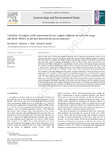Toxicities of copper oxide nanomaterial and copper sulphate in early life stage zebrafish: Effects of pH and intermittent pulse exposure
| dc.contributor.author | Boyle, D | |
| dc.contributor.author | Clark, Nathaniel | |
| dc.contributor.author | Handy, Richard | |
| dc.date.accessioned | 2020-10-05T17:30:30Z | |
| dc.date.issued | 2020-03-01 | |
| dc.identifier.issn | 0147-6513 | |
| dc.identifier.issn | 1090-2414 | |
| dc.identifier.other | 109985 | |
| dc.identifier.uri | http://hdl.handle.net/10026.1/16480 | |
| dc.description.abstract |
Effort has been made to standardise regulatory ecotoxicity tests for engineered nanomaterials (ENMs), but the environmental realism of altered water quality and/or pulse exposure to these pollutants should be considered. This study aimed to investigate the relative toxicity to early life-stage zebrafish of CuO ENMs at acid pH and then under pulse exposure conditions, all compared to CuSO4. At all pH values, CuSO4 was more toxic to zebrafish than CuO ENMs. Additions of H+ were protective of CuSO4 toxicity, with median lethal concentrations LC50 (with 95% confidence intervals) of: 0.36 (0.33-0.40), 0.22 (0.20-0.24) and 0.27 (0.25-0.29) mg L-1 at pH 5, pH 6 and pH 7, respectively. In contrast, the toxicity of CuO ENMs increased with acidity; LC50 values were: 6.6 (4.5-8.5), 19.4 (11.6-27.2) and >100 mg L-1 at pH 5, pH 6 and pH 7, respectively. The increased toxicity of the CuO ENMs in acid water corresponded with greater dissolution of dissolved Cu from the particles at low pH, suggesting free Cu2+ ion delivery to the zebrafish was responsible for the pH-effect. In continuous 96 h exposures to the substances at the LC10 values and at pH 6, both CuSO4 and CuO ENMs caused Cu accumulation, inhibition of Na+/K+-ATPase and depletion of total glutathione in zebrafish. However, two 24 h pulses of CuSO4 or CuO ENMs at the same peak concentration caused similar effects to the continuous 96 h exposure, despite the shorter exposure durations of the former; suggesting that the pulses were more hazardous than the continuous exposure. In conclusion, the current water quality correction for pH with respect to Cu toxicity to freshwater fish should not be applied to the nano form. Crucially, CuO ENMs are more toxic in pulse than continuous exposure and new corrections for both water pH and the Cu exposure profile are needed for environmental risk assessment. | |
| dc.format.extent | 109985-109985 | |
| dc.format.medium | Print-Electronic | |
| dc.language | en | |
| dc.language.iso | en | |
| dc.publisher | Elsevier BV | |
| dc.rights | Attribution-NonCommercial-NoDerivatives 4.0 International | |
| dc.rights | Attribution-NonCommercial-NoDerivatives 4.0 International | |
| dc.rights | Attribution-NonCommercial-NoDerivatives 4.0 International | |
| dc.rights | Attribution-NonCommercial-NoDerivatives 4.0 International | |
| dc.rights | Attribution-NonCommercial-NoDerivatives 4.0 International | |
| dc.rights.uri | http://creativecommons.org/licenses/by-nc-nd/4.0/ | |
| dc.rights.uri | http://creativecommons.org/licenses/by-nc-nd/4.0/ | |
| dc.rights.uri | http://creativecommons.org/licenses/by-nc-nd/4.0/ | |
| dc.rights.uri | http://creativecommons.org/licenses/by-nc-nd/4.0/ | |
| dc.rights.uri | http://creativecommons.org/licenses/by-nc-nd/4.0/ | |
| dc.subject | Copper toxicity | |
| dc.subject | Early life stage | |
| dc.subject | Nanoparticles | |
| dc.subject | Oxidative stress | |
| dc.subject | pH | |
| dc.subject | Pulse exposure | |
| dc.title | Toxicities of copper oxide nanomaterial and copper sulphate in early life stage zebrafish: Effects of pH and intermittent pulse exposure | |
| dc.type | journal-article | |
| dc.type | Journal Article | |
| plymouth.author-url | https://www.webofscience.com/api/gateway?GWVersion=2&SrcApp=PARTNER_APP&SrcAuth=LinksAMR&KeyUT=WOS:000509438100004&DestLinkType=FullRecord&DestApp=ALL_WOS&UsrCustomerID=11bb513d99f797142bcfeffcc58ea008 | |
| plymouth.volume | 190 | |
| plymouth.publication-status | Published | |
| plymouth.journal | Ecotoxicology and Environmental Safety | |
| dc.identifier.doi | 10.1016/j.ecoenv.2019.109985 | |
| plymouth.organisational-group | /Plymouth | |
| plymouth.organisational-group | /Plymouth/Faculty of Science and Engineering | |
| plymouth.organisational-group | /Plymouth/Faculty of Science and Engineering/School of Biological and Marine Sciences | |
| plymouth.organisational-group | /Plymouth/REF 2021 Researchers by UoA | |
| plymouth.organisational-group | /Plymouth/REF 2021 Researchers by UoA/UoA06 Agriculture, Veterinary and Food Science | |
| plymouth.organisational-group | /Plymouth/REF 2021 Researchers by UoA/UoA07 Earth Systems and Environmental Sciences | |
| plymouth.organisational-group | /Plymouth/Research Groups | |
| plymouth.organisational-group | /Plymouth/Research Groups/Marine Institute | |
| plymouth.organisational-group | /Plymouth/Users by role | |
| plymouth.organisational-group | /Plymouth/Users by role/Academics | |
| dc.publisher.place | Netherlands | |
| dcterms.dateAccepted | 2019-11-16 | |
| dc.rights.embargodate | 2020-12-13 | |
| dc.identifier.eissn | 1090-2414 | |
| dc.rights.embargoperiod | Not known | |
| rioxxterms.versionofrecord | 10.1016/j.ecoenv.2019.109985 | |
| rioxxterms.licenseref.uri | http://creativecommons.org/licenses/by-nc-nd/4.0/ | |
| rioxxterms.licenseref.startdate | 2020-03-01 | |
| rioxxterms.type | Journal Article/Review | |
| plymouth.funder | Sustainable Nanotechnologies (SUN)::European Commission FP7 |



